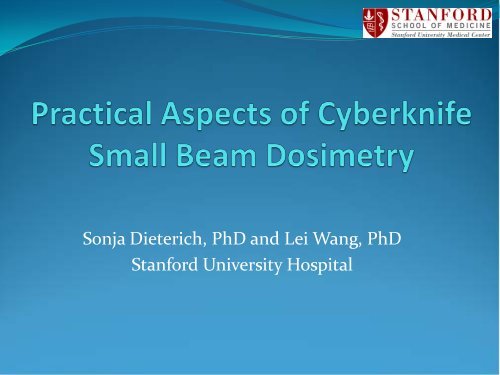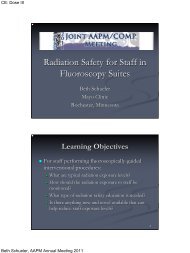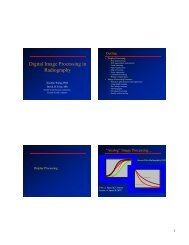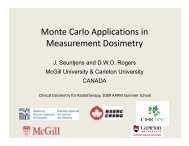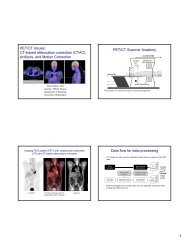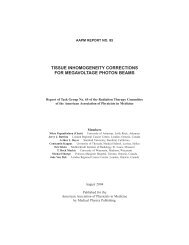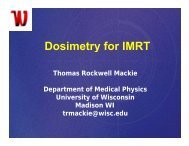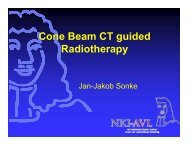Practical Aspects of Cyberknife Small Beam Dosimetry
Practical Aspects of Cyberknife Small Beam Dosimetry
Practical Aspects of Cyberknife Small Beam Dosimetry
Create successful ePaper yourself
Turn your PDF publications into a flip-book with our unique Google optimized e-Paper software.
Sonja Dieterich, PhD and Lei Wang, PhD<br />
Stanford University Hospital
Conflict <strong>of</strong> Interest<br />
Sonja Dieterich has a consulting agreement with<br />
Cyberheart, Inc.
Outline<br />
� Reference dosimetry<br />
� TG-51<br />
� Detectors<br />
� Independent output check<br />
� Relative <strong>Dosimetry</strong><br />
� Output Factors<br />
� OARs<br />
� <strong>Practical</strong> Comments on taking dosimetry data<br />
� Tools needed<br />
� Time required<br />
� Order <strong>of</strong> measurement
The IAEA concept<br />
Alfonso et al, Med Phys (2008), 5179<br />
• CyberKnife: machine-specific<br />
static reference field<br />
• 60 mm collimator, 80 cm SAD
TG-51 for flattening filter only? No!<br />
TPR 20 10<br />
Kalach & Rogers, Med Phys 30 (2003) 1546<br />
TG51 is using %dd(10) x
TG-51: Measuring %dd(10) x<br />
� CK: 60 mm spherical collimator at 80 cm SAD<br />
� Measure at 10 cm depth, 100 cm SSD, 60 mm collimator<br />
� Calculate equivalent square<br />
� Interpolate to 80 cm SAD using the BJR data
TG-51: Chamber selection<br />
• Dose flatness insufficient for Farmer-type chamber<br />
• Cavity length should be 1 cm or shorter<br />
• Option: cross calibrate a short chamber with Farmer-type chamber<br />
Kawachi et al, Med Phys (2008) 4591
Independent Output Check<br />
� Absolutely necessary<br />
before treating a patient!<br />
� Same institute: crosscalibrate<br />
(TLD)<br />
� Stand-alone site: TLD<br />
service
Outline<br />
� Reference dosimetry<br />
� TG-51<br />
� Chambers<br />
� Independent output check<br />
� Relative <strong>Dosimetry</strong><br />
� Output Factors<br />
� OARs<br />
� <strong>Practical</strong> Comments on taking <strong>Beam</strong> Data<br />
� Tools needed<br />
� Time required<br />
� Order <strong>of</strong> measurement
Goal: OF Uncertainty < 3%<br />
� Francescon, Cora, Cavedon, Med Phys (2008) 504<br />
� OF (= s c,p) for 3 smallest cones:<br />
� 2 microchambers, PTW60012 diode, diamond detector<br />
� Measurements<br />
� Monte Carlo simulation<br />
Consistency Check<br />
� Dependency <strong>of</strong> OF on FWHM <strong>of</strong> electron beam<br />
� MC correction factors for detector response
Point source assumption<br />
starts breaking down for<br />
5 mm collimator!<br />
OF as Function <strong>of</strong><br />
Electron-<strong>Beam</strong> FWHM
OF Correction Factor F corr<br />
� No lateral electron equilibrium<br />
� Detector response : F corr = OF (MC) / OF (measured)<br />
� Combine detector correction with FWHM correction to get s* c,p
OF Corrections: Results<br />
� Vicenza study results in low<br />
uncertainty <strong>of</strong> OFs if all<br />
corrections apply<br />
� Pantelis Med Phys (2008)<br />
2312 BANG gel measurement<br />
strong indication for OF<br />
correction factor
OF corrections: What now?<br />
� Convince me to change the 5 mm OF for my machines:<br />
� # <strong>of</strong> published papers agreeing on factor?<br />
� Doing my own, independent simulation? (Time, resources)<br />
� CyberKnife-wide consensus? (“Lets all decide on a number”)<br />
� IF we change, how do we account for it in medical literature<br />
(e.g. trigeminal neuralgia)?<br />
� OF is usually not mentioned in physicians’ papers<br />
� Potential for errors in retrospective analyses<br />
� We will have to discuss soon!
1.000<br />
0.800<br />
0.600<br />
0.400<br />
0.200<br />
0.000<br />
OAR Width vs. Detector Size<br />
1.5cm depth<br />
5c 7.5c<br />
10c 12.5c<br />
15c site 5c<br />
site 7.5c site 10c<br />
site 12.5c site 15c<br />
0.0 2.0 4.0 6.0 8.0 10.0 12.0 14.0<br />
� Width <strong>of</strong> PTW60012<br />
diode compared to<br />
small collimator OARs<br />
� Use film as alternative?<br />
Other issues …<br />
� Do we need to deconvolve?<br />
� No published literature<br />
(yet)
Outline<br />
� Reference dosimetry<br />
� TG 51<br />
� Detectors<br />
� Independent output check<br />
� Relative <strong>Dosimetry</strong><br />
� Output Factors<br />
� OARs<br />
� <strong>Practical</strong> Comments on taking <strong>Beam</strong> Data<br />
� Tools needed<br />
� Time required<br />
� Order <strong>of</strong> measurement
Tools needed<br />
� Water phantom:<br />
� 3D tank with CAX correction<br />
� Be able to program star-pattern for IRIS<br />
� Detectors:<br />
� (Farmer chamber)<br />
� Chamber with length < 1 cm<br />
� Diode & Reference Diode<br />
� PTW60012 (current standard)<br />
� Sun Nuclear Edge detector (hear lots <strong>of</strong> good things about it)<br />
� Other diodes<br />
� Other Detectors (Bang gels, Diamond detectors, film …)
How much time is required?<br />
1 Fixed<br />
Collimator<br />
1 IRIS<br />
collimator<br />
Total/nozzle<br />
(hours)<br />
OF (3 SADs) 10 min 10 min 2 4<br />
TPR* 1.5 – 2 hrs 1.5 – 2 hrs 18 - 24 36 - 48<br />
OCR* 1.5 – 2 hrs 1.5 – 2 hrs 18 - 24 36 -48<br />
MC data acqu. N/A N/A 1 2<br />
TG 51 0.5-1 N/A 0.5 - 1 0.5 - 1<br />
Total (hours)<br />
Total 3.5 - 5 3-4 40 - 51 78.5 - 103<br />
• No automated tool to move robot �<br />
• Time depends on position <strong>of</strong> robot teach pendant<br />
(outside room vs. inside room for each depth change)<br />
• NOT Accuray recommended to watch by camera only …
Order <strong>of</strong> Measurement<br />
1. OF first!<br />
� Most difficult<br />
� Check inverse square law first (diodes go bad …)<br />
2. TPR, PDD, OCR<br />
� Fixed collimators first, then IRIS<br />
� TPRs for all cones<br />
� Then PDD for annual/quick reference!<br />
� OCRs for each cone<br />
3. Process fixed cone data (ready to go live!)<br />
4. Then process IRIS during the day, fixed cone MC during night<br />
5. Last comes IRIS MC<br />
6. Most efficient way to treatment!
Conclusion<br />
� We have learned how to do TG 51 for CK<br />
� The smallest cones remain a challenge, but …<br />
� … we have several published papers on OF now<br />
� Follow the literature<br />
� Evaluate new detectors for suitability<br />
� Definitely need more efficient beam data taking tools


